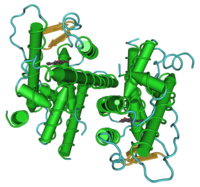| estrogen receptor 1 (ER-alpha) | |||||||
|---|---|---|---|---|---|---|---|
 | |||||||
| Identifiers | |||||||
| Symbol | ESR1 | ||||||
| Alt. symbols | ER-α, NR3A1 | ||||||
| NCBI gene | 2099 | ||||||
| HGNC | 3467 | ||||||
| OMIM | 133430 | ||||||
| PDB | 1ERE | ||||||
| RefSeq | NM_000125 | ||||||
| UniProt | P03372 | ||||||
| Other data | |||||||
| Locus | Chr. 6 q24-q27 | ||||||
| |||||||
| estrogen receptor 2 (ER-beta) | |||||||
|---|---|---|---|---|---|---|---|
 | |||||||
| Identifiers | |||||||
| Symbol | ESR2 | ||||||
| Alt. symbols | ER-β, NR3A2 | ||||||
| NCBI gene | 2100 | ||||||
| HGNC | 3468 | ||||||
| OMIM | 601663 | ||||||
| PDB | 1QKM | ||||||
| RefSeq | NM_001040275 | ||||||
| UniProt | Q92731 | ||||||
| Other data | |||||||
| Locus | Chr. 14 q21-q22 | ||||||
| |||||||
Estrogen receptors (ERs) are proteins found in cells that function as receptors for the hormone estrogen (17β-estradiol).[1] There are two main classes of ERs. The first includes the intracellular estrogen receptors, namely ERα and ERβ, which belong to the nuclear receptor family. The second class consists of membrane estrogen receptors (mERs), such as GPER (GPR30), ER-X, and Gq-mER, which are primarily G protein-coupled receptors. This article focuses on the nuclear estrogen receptors (ERα and ERβ).
Upon activation by estrogen, intracellular ERs undergo translocation to the nucleus where they bind to specific DNA sequences. As DNA-binding transcription factors, they regulate the activity of various genes. However, ERs also exhibit functions that are independent of their DNA-binding capacity.[2] These non-genomic actions contribute to the diverse effects of estrogen signaling in cells.
Estrogen receptors (ERs) belong to the family of steroid hormone receptors, which are hormone receptors for sex steroids. Along with androgen receptors (ARs) and progesterone receptors (PRs), ERs play crucial roles in regulating sexual maturation and gestation. These receptors mediate the effects of their respective hormones, contributing to the development and maintenance of reproductive functions and secondary sexual characteristics.
- ^ Dahlman-Wright K, Cavailles V, Fuqua SA, Jordan VC, Katzenellenbogen JA, Korach KS, et al. (December 2006). "International Union of Pharmacology. LXIV. Estrogen receptors". Pharmacological Reviews. 58 (4): 773–781. doi:10.1124/pr.58.4.8. PMID 17132854. S2CID 45996586.
- ^ Levin ER (August 2005). "Integration of the extranuclear and nuclear actions of estrogen". Molecular Endocrinology. 19 (8): 1951–1959. doi:10.1210/me.2004-0390. PMC 1249516. PMID 15705661.